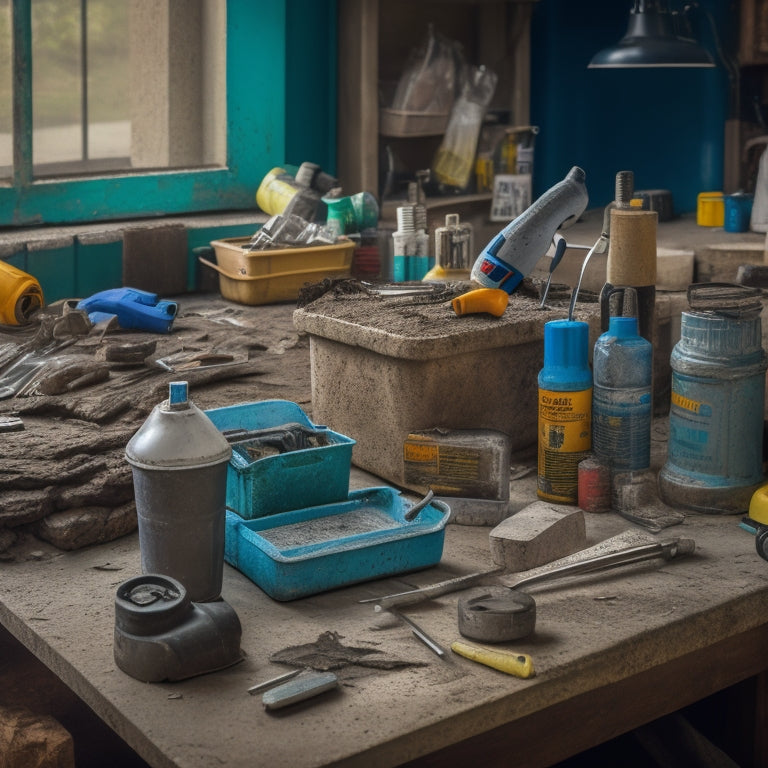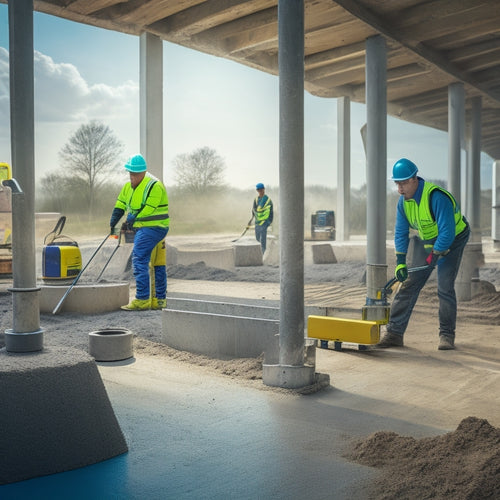
5 Best Tools for Concrete Repair and Injection
Share
When tackling concrete repair and injection projects, you'll need a range of specialized tools to guarantee success. Start with crack detection and assessment tools to identify and evaluate cracks, then use epoxy injection gun systems for precise control over the injection process. Concrete drill bits and accessories facilitate efficient removal of damaged concrete, while crack preparation and cleaning tools get the surface ready for repair. Finally, injection material dispensing tools deliver the right amount of material into the prepared cracks. By having these five essential tools in your arsenal, you'll be well-equipped to tackle even the most challenging concrete repair projects, and uncover the specifics of each tool to take your skills to the next level.
Key Takeaways
• Crack detection and assessment tools identify and evaluate cracks, determining severity for effective repair strategies.
• Epoxy injection gun systems provide precise control over epoxy resin injection, optimizing formulation for tailored repair solutions.
• Concrete drill bits and accessories facilitate efficient removal of damaged concrete, ensuring successful drilling aligned with repair requirements.
• Crack preparation and cleaning tools remove debris and contaminants, roughening surfaces for improved mechanical bonding.
• Injection material dispensing tools deliver crack sealing materials accurately, ensuring correct pressure, flow rate, and volume for effective filling.
Crack Detection and Assessment Tools
You use crack detection and assessment tools to identify and evaluate cracks in concrete structures, enabling you to determine the severity of the damage and develop an effective repair strategy.
These tools are essential in crack monitoring, allowing you to identify the location, width, and depth of cracks, as well as their orientation and pattern.
Assessment techniques, such as visual examination, acoustic emission testing, and infrared thermography, provide valuable insights into the crack's behavior and potential for further propagation.
By analyzing the data collected, you can classify cracks based on their severity, prioritize repairs, and select the most suitable repair method.
Accurate crack detection and assessment are critical in guaranteeing that repairs are effective and long-lasting.
Furthermore, they help prevent further damage, reduce maintenance costs, and extend the lifespan of the structure.
Epoxy Injection Gun Systems
With epoxy injection gun systems, contractors can accurately dispense and inject epoxy resin into cracks and voids, guaranteeing precise control over the repair process. These systems are designed to optimize epoxy formulation techniques, allowing for tailored solutions to specific repair needs. By managing injection pressure, you can guarantee that the epoxy resin flows smoothly and consistently, filling even the smallest cracks and voids.
When selecting an epoxy injection gun system, consider the following key features:
| Feature | Importance |
|---|---|
| Pressure Control | High |
| Flow Rate Adjustment | Medium |
| Material Compatibility | High |
| Ergonomic Design | Low |
Concrete Drill Bits and Accessories
Concrete drill bits and accessories play an essential role in preparing surfaces for repair, as they enable efficient and precise removal of damaged or deteriorated concrete.
You'll need the right tools to guarantee a successful repair job. When it comes to drilling into concrete, you have two main options: diamond core drill bits and masonry drill bits.
Here are three key considerations when selecting concrete drill bits and accessories:
-
Drill bit type: Diamond core drill bits are ideal for drilling large holes and making precise cuts, while masonry drill bits are better suited for smaller holes and general-purpose drilling.
-
Drill bit size: Choose a drill bit that matches the size of the hole you need to drill, taking into account the thickness of the concrete and the type of repair you're performing.
-
Accessory compatibility: Confirm that your drill bits are compatible with your drill and other accessories, such as extension rods and drill chucks, to optimize your drilling efficiency.
Crack Preparation and Cleaning
After drilling into the concrete, it's time to focus on preparing and cleaning the cracks to secure a strong bond between the old and new material. This essential step guarantees that the crack sealing material adheres properly, preventing future failures.
You'll need to remove any debris, dust, or loose particles from the cracks using a wire brush, air compressor, or vacuum cleaner. For more stubborn debris, you can use a crack chaser or a saw-cutting machine to widen the crack and create a clean surface.
Surface preparation is important for successful crack sealing. You'll need to degrease the area using a solvent-based cleaner to remove any oils or contaminants.
Then, use a concrete surface preparation tool to roughen the surface, creating a strong mechanical bond between the old and new material. This process helps to increase the surface area, allowing the crack sealing material to bond more effectively.
Injection Material Dispensing Tools
You'll need a reliable injection material dispensing tool to accurately deliver the crack sealing material into the prepared cracks. This tool is essential in guaranteeing the material is dispensed at the correct pressure, flow rate, and volume to fill the crack effectively.
When selecting an injection material dispensing tool, consider the following key factors:
-
Compatibility with various injection material types: Verify the tool can handle different viscosities and flow rates of materials, such as epoxies, polyurethanes, and acrylics.
-
Dispensing techniques and control: Look for tools that offer precise control over the dispensing process, including manual or automated systems, and adjustable flow rates.
-
Ease of use and maintenance: Choose a tool that's ergonomic, easy to clean, and maintain, reducing the risk of clogging and guaranteeing consistent performance.
Frequently Asked Questions
What Safety Precautions Should Be Taken When Working With Epoxy Injection Materials?
When working with epoxy injection materials, you must take necessary safety precautions to avoid exposure and potential harm.
Follow epoxy handling guidelines to minimize risks. Wear personal protective equipment (PPE) like gloves, safety glasses, and a mask to prevent skin contact and inhalation of fumes.
Ascertain good ventilation, and avoid eating or drinking near the work area.
Always read and follow the manufacturer's instructions and safety data sheets (SDS) for specific guidelines on handling and use.
Can I Use a Regular Drill for Concrete Drilling and Injection?
Did you know that over 80% of concrete repair failures are due to improper drilling techniques?
When it comes to concrete drilling and injection, you'll need a drill that can handle the task.
You can't use a regular drill, as it may not provide the necessary torque and speed for effective injection.
Instead, opt for a rotary hammer drill or a core drill, specifically designed for concrete drilling.
These drill types, paired with the right injection techniques, will guarantee a successful repair.
How Do I Choose the Right Type of Concrete Repair Material for My Project?
When selecting a concrete repair material, you'll need to evaluate the specific requirements of your project.
Research different concrete repair types, such as epoxy, polyurethane, and cement-based materials.
Compare their performance regarding strength, durability, and bonding capabilities.
Evaluate factors like temperature range, chemical resistance, and UV stability to ascertain the material can withstand your project's conditions.
What Is the Typical Cost of a Concrete Repair and Injection Project?
When estimating the typical cost of a concrete repair and injection project, you'll need to take into account various cost factors. These include the type and quantity of materials, labor costs, equipment rental fees, and the complexity of the repair.
To create an accurate project budget, you'll need to assess the scope of the project, identify potential challenges, and research local market rates for materials and labor.
How Long Does a Typical Concrete Repair and Injection Project Take to Complete?
You're wondering how long a typical concrete repair and injection project takes to complete.
The project timeline largely depends on the scope, complexity, and repair techniques employed.
For instance, simple crack injection may take a few hours, while extensive structural repairs can span weeks or even months.
It's crucial to assess the damage, choose the right techniques, and create a detailed project schedule to guarantee a timely and successful completion.
Conclusion
As you wrap up your concrete repair and injection project, remember that having the right tools is like having a trusty time machine - it helps you fix the past and secure the future.
With the right gear, you'll be injecting epoxy like a pro, filling cracks with ease, and ensuring your concrete structure stands the test of time.
From detection to dispensing, these five tools will be your new best friends on the job site.
Related Posts
-

7 Must-Have Tools for Concrete Repair Organization
To effectively organize your concrete repair projects, you'll need a thorough toolkit that includes a well-planned st...
-

5 Best Tools for Stamping Concrete Walls
When it comes to stamping concrete walls, you'll need a range of specialized tools to achieve the desired texture and...
-

What Tools Ensure Precise Concrete Leveling Results
You need a range of specialized tools to achieve precise concrete leveling results. Laser leveling instruments provid...


